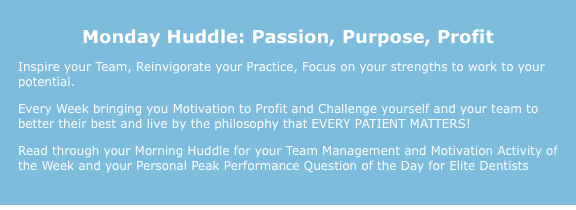I’m sure you remember hearing the phrase, “The way you see the problem is the problem.” And this is so incredibly true.
One reason, among many, why pictures work so well to “sell” treatment is because it makes the problems believable and undeniable. They illustrate to the patient the reality of the situation.
In every practice, photographs are the most underutilized resource when it comes to clinically working with the patient and getting case acceptance on the treatment. We talk about that all the time.
Even still, seeing is not always enough. It’s more than just the picture, it’s about the perception and the significance the patient places on the problem they see.
That’s why the best way to ensure effective and successful patient outcomes is to ask more questions.
The use of questions maybe the single best tool in terms of human engagement for any part of your patient experience. The only way to really understanding someone else (what they think, what they see, what they are going to do), is to ask them.
Today, I would like you to focus on assessing your use of questions and to create a list of the questions most applicable to you in the role you play within the practice with your patients.
There are probing questions…
“I see, tell me more about this, how long have you been considering implants?”
Questions of concern…
“This doesn’t look so good, how bad does that hurt?”
Questions to follow-up a response…
“I see, I’d like to know what you mean when you say you don’t really care about keeping your teeth, what are you thinking in terms of the alternative?”
Questions to spur engagement…
“Will you hold this for me, I’d like you to feel the sturdiness of the implant yourself.”
Questions about the photographs…
“Do you see that tooth right there, what do you notice about it compared to the others?”
Questions about their decision (or lack thereof)…
“After our discussion today, I’m surprised and I’d really like to know what is holding you back from doing what’s best for your long term health?”
There are challenge questions…
“I wouldn’t let insurance stand in the way of doing something so important and time sensitive for yourself, you aren’t going to let them get the best of you, are you?”
At every point: phone call, follow-up, intake, interview, clinical experience, the comprehensive exam, getting the clinical yes, closing the case, getting money, scheduling, etc – you can use questions to move patients forward.
I’ve just given you a random sampling. You can customize based on your personality and your position. Every team member and doctor should have a list of go to questions. You can even create a checklist that you carry around.
This is the difference between the amateurs and the professionals. Using questions and having your playbook ready to go so you can help your patients get healthy and be prepared to serve as a guide to their health and what is in their very best interest.
Get to work, make your list and practice on each other. By the way, the funny thing is, you only need a few great questions to redirect patients back to the main point or the matter at hand.



